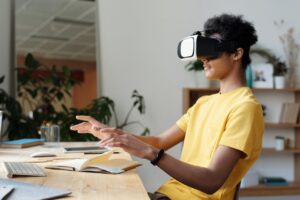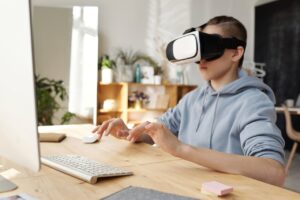

In recent years, the integration of Virtual Reality (VR) and Artificial Intelligence (AI) has opened up exciting new possibilities in education. This article explores how these technologies are reshaping the landscape of school education, offering innovative solutions for both students and teachers.
While VR education apps have gained prominence in STEM fields, their applications extend far beyond science and mathematics. How can VR be used in education across various subjects? Let’s explore:
Beyond traditional subjects, VR education software is also being used to develop crucial life skills:

What is a practical lesson in the context of VR? It’s an immersive, interactive experience that allows students to engage with subject matter in ways previously impossible. For example, in a biology class, students might use VR to explore the human body at a cellular level, offering a new perspective on what is science lesson.
VR education companies are developing specialized applications for various educational needs. For instance, some VR education games focus on medical training, allowing high school students in specialized classes to experience surgical procedures or emergency room scenarios safely.
The integration of AI in education benefits both students and teachers in numerous ways:

When combined, VR and AI create powerful educational tools. For example:
Several VR education services are already implementing these technologies:
As we look to the future, school lesson pro games and VR experiences will likely become integral parts of education. These technologies have the potential to make learning more engaging, effective, and accessible.
For educators interested in exploring these possibilities, many VR education companies offer free VR education apps for trial. For instance, XReady Lab provides free demos of their VR simulations. To experience how VR can transform your school lessons, especially in STEM subjects, visit https://xreadylab.com/request-demo-page/ and request a free demo. Even without VR hardware, you can access desktop versions to get started.
The intersection of VR and AI in education represents a significant leap forward in how we approach teaching and learning. By providing immersive experiences, personalized learning paths, and powerful analytical tools, these technologies are set to revolutionize education at all levels.
As we embrace these innovations, it’s important to remember that they are tools to enhance, not replace, the crucial role of teachers. The future of education lies in harnessing the power of VR and AI to create more engaging, effective, and inclusive learning environments for all students.
Frequently Asked
We prodive VR biology, VR physics, and VR chemistry simulations. Please, check our catalog.
Please, fill the form to get demo labs for free.
Please contact our customer support service at support@xreadylab.com or book a call with the team to find out the conditions and book the VR class set up at your school.
Subscription to XReady Lab interactive VR labs. If you are a school, then you are also given access to the VR classroom system. VR class system helps you easily launch VR lessons for a large number of students, follow the experience of each student, as well as customise the content without developers.
We adhere to the world’s generally accepted recommendations and research. Our products are suitable for children from 12 years old.